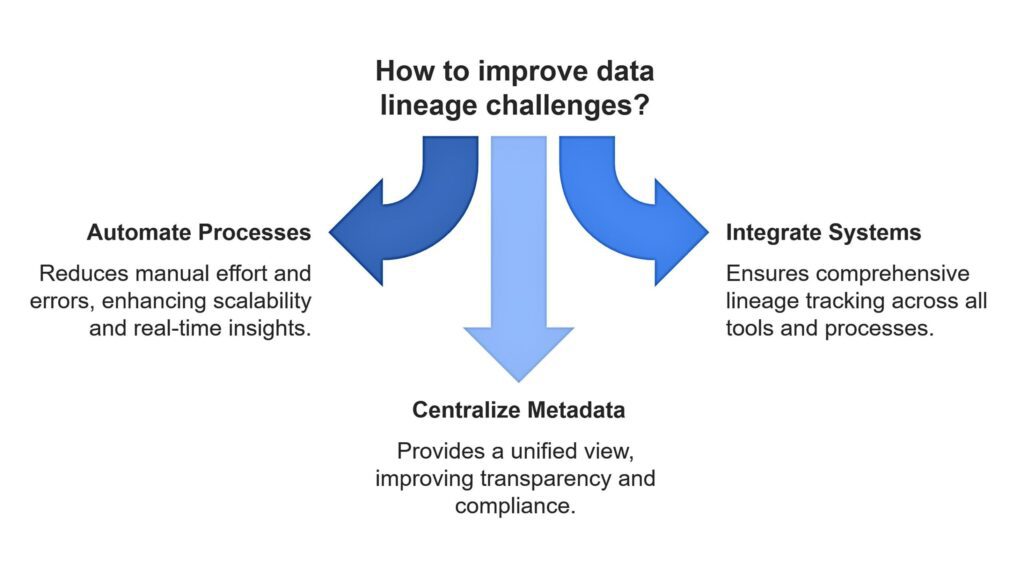- May 20, 2025
Reimagining Data Lineage - How Generative AI is Transforming Trust and Compliance
Over 70% of enterprises struggle with incomplete or outdated data lineage.
Data lineage is no longer a nice-to-have understanding of where your data comes from, how it transforms, and where it goes.
It has now become foundational to data governance, quality, and compliance. However, it was becoming almost as fragmented, dynamic, and complex as these newfangled data environments have become, and traditional approaches have been totally unable to keep track.
Cloud-native architecture, dynamic pipeline, and growing toolchains have compounded the enterprise data environment, creating an overwhelming surge in data lineage challenges.
As with most legacy offerings, these solutions are based on manual configurations and rule-based logic that cannot scale or adapt to real-time scenarios.
This is where generative artificial intelligence in data management brings substantial difference. Let’s deep dive into this article to find insights on how GenAI can resolve data lineage challenges and set the right track for businesses to perform well.
Why wait? Time to explore!
What Is Data Lineage and Why It’s So Challenging Today?

Data lineage means knowing where data came from, where the data has traveled, how it has been transformed, and where it was eventually consumed within the enterprise.
Lineage helps teams understand how datasets are interrelated, altered, and consumed through various tools and processes. Data lineage, in principle, means providing confidence and transparency over the entire data lifecycle.
This functionality stands at the core of data governance, allowing organizations to build walls around policies, quality standards, and compliance obligations such as GDPR, HIPAA, and SOX.
These laws, in turn, create trust in the data with a clear line of view on its journey and transformations. But unraveling this thread seems to have never been more difficult.
One of the biggest reasons for the complications is the reliance on manual interventions. Data engineers often spend hours manually mapping dependencies, writing custom scripts, or managing lineage documentation.
These ways are labor-consuming and often subjected to human errors, mostly uncommon. The conventional tools also frequently build only partial lineage-they do not include the transformations from code or amongst loosely integrated systems.
This is exactly the reverse of what solves the issue of not being able to scale lineage solutions with fast-growing data landscapes and not delivering real-time insights only aggravates it.
Besides, many teams operate in silos where tools do not share metadata or lineage context, rendering centralized visibility almost impossible.
How Generative AI Can Help
Generative AI in data management presents a whole new way of addressing such age-old problems of data lineage. It allows AI agents to exploit large language models to mine and analyze all sources of information, from metadata repositories, logs, and SQL queries to codebases, for the automatic identification of lineage relationships.
Often termed automatic data lineage tracking, this method cuts down the time and effort required for discovery and mapping. Such agents can compile and identify lineage pathways across systems, even mapping data lineage automatically in complicated environments when transformations are embedded in custom scripts or orchestrated workflows.
One of the most transformational aspects is the natural language capability of describing the lineage paths. User-friendly to business audiences and non-technical stakeholders alike, it allows anyone to raise a simple question such as “Where does this report data come from?” and receive a detailed, yet comprehensible, answer.
Finally, AI agents guarantee that data lineage maps are self-updating and reflect any changes dynamically through the evolution of data pipelines.
Furthermore, they can provide proactive impact analysis, assessing any downstream impact of a proposed change to a pipeline, thereby minimizing the risk of breaking critical flows or introducing errors.
Benefits of Using Generative AI for Data Lineage

Automated lineage discovery
Generative AI automates the discovery of data lineage by scanning metadata, logs, and codebases, thereby reducing the need for manual mapping. The result is faster and more accurate tracing of data flows in complex systems.
Real-time updates
AI agents undertake continuous monitoring of the changes occurring in the data pipelines and update all lineage maps without any human intervention. Real-time data lineage should be tracked, and issue detection should be done proactively in this fashion.
Improved data trust
With greater transparency, AI-driven insights allow users to understand how data has been transformed and moved, thereby increasing confidence in the data that they are using. This increases data quality and supports informed decision-making.
Accelerated root cause analysis
AI can trace errors and anomalies quickly back through the data pipelines, allowing for reduced downtime and manual investigation. This considerably speeds up the resolution of data issues.
Automated data lineage mapping will ensure that data origins and transformations are trackable in a manner meeting regimens such as GDPR, HIPAA, etc. It simplifies audits and improves AI-powered data governance.
Increased Productivity
GenAI eliminates the burden of performing the same repetitive tasks over and over again, such as documentation or manually tracing data flows. This allows engineering resources to focus on doing productive and strategic things.
Contextual impact analysis
LLMs can predict how a change in one dataset affects downstream assets and offer this knowledge to teams to help them anticipate trouble. This context-aware insight is crucial to affect any change safely and effectively in pipeline.
Cross-system visibility
Generative AI unites siloed tools and data systems into one unified view of the entire data landscape, benefiting data transparency at the enterprise level.
Visual lineage maps
AI produces interactive and convenient navigation of lineage visualizations, breaking down complex data interrelationships. Such maps promote faster understanding, communication, and decision-making.
Real-World Use Cases
This is exactly what organizations across industries are already viewing on the ground. For example, one of the global financial institutions has used generative AI in data management, which manages lineage across more than 200 systems automatically discovering connections and transformations that were hidden or undocumented.
- One provider in the healthcare sector develops AI-enabled data governance tools for the purpose of keeping data lineage for HIPAA compliance to allow tracing of patient data in a secure and transparent way.
- One tech startup has reduced lineage setup time by more than 70% with automated data lineage tracking using AI agents.
These agents provided not only initial mapping but also real-time updates of the lineage. In another case, AI agents would proactively mention discrepancies in lineage paths to allow the engineer prevention measures before escalation into data incidents.
Implementation Considerations
Effectively introducing data lineage utilizing AI agents, organizations would have to provide initial training of their AI models on their internal metadata and systems.
This context would allow the recognition of patterns and transformations made with meaning by the AI. Data silos and schema drift should also be taken into consideration because they have the potential to disturb lineage visibility in case, they go unmanaged.
Security is another one of the main challenges. Since AI tracks sensitive data flows, privacy provisions should be put in place to protect data and ensure compliance.
Selection of AI platform or vendor is highly determined, and providers with open integrations and scalability should be sought.
Finally, successful implementation often hinges on proper integration with existing data catalogs, observability tools, and governing frameworks.
Conclusion & Future Outlook
Data lineage is one of the things generative AI is radically changing into something that organizations can now use. Traditional solutions were basically sabotaged by their weaknesses in manual processes, real-time visibility, and natural language understandability. AI-enabled data governance, once an aspiration, is now looking very much like a necessity.
The coming years will see a new emergence of autonomous data observability platforms, with lineage, quality, and compliance maintained automatically. AI agents will become ever more proactive, acting as ‘lineage co-pilots’ to help data teams stay one step ahead of issues. With the rise in discussion around ethical AI and governance, organizations will have to embrace AI-driven data management for what it is and for its responsibilities.
Happy Learning!!
Ready to bring transparency and trust to your data systems?
Discover how generative AI can simplify and scale your data lineage strategy.
FAQs
1. How can AI improve data lineage tracking across complex systems?
Artificial Intelligence revolutionizes process tracking, analyzing metadata, logs, and code to plant data flows in decentralized and/or intricate data systems without the overheads of manual humming, increasing accuracy.
2. Can Generative AI detect broken data pipelines in real time?
Real-time monitoring of data pipelines to catch breaks or anomalies can use Generative AI and its ability to identify deviations from regular patterns of behavior that the data is supposed to display.
3. What are the compliance benefits of AI-powered data lineage?
AI-powered data lineage contributes to compliance as it provides a clear and traceable record of data movement and transformation, thus making audits less burdensome and regulatory transparency possible.
4. How do self-updating data lineage maps work with Generative AI?
Self-updating lineage maps automatically refresh the lineage view whenever data pipelines change by leveraging Generative AI, continuously analyzing the changes in systems, metadata, and logs.




